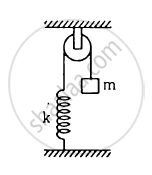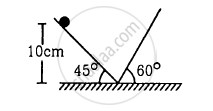Advertisements
Advertisements
Question
Consider a simple harmonic motion of time period T. Calculate the time taken for the displacement to change value from half the amplitude to the amplitude.
Solution
As per the conditions given in the question,
\[y_1 = \frac{A}{2}; \]
\[ y_2 = A\]
(for the given two positions)
Let y1 and y2 be the displacements at the two positions and A be the amplitude.
Equation of motion for the displacement at the first position is given by,
y1 = Asinωt1
As displacement is equal to the half of the amplitude,
\[\frac{A}{2} = A \sin \omega t_1\]
\[\Rightarrow \sin \omega t_1 = \frac{1}{2}\]
\[ \Rightarrow \frac{2\pi \times t_1}{T} = \frac{\pi}{6}\]
\[ \Rightarrow t_1 = \frac{T}{12}\]
The displacement at second position is given by,
y2 = A sin ωt2
As displacement is equal to the amplitude at this position,
⇒ A = A sin ωt2
⇒ sinωt2 = 1
\[\Rightarrow \omega t_2 = \frac{\pi}{2}\]
\[ \Rightarrow \left( \frac{2\pi}{T} \right) t_2 = \frac{\pi}{2} \left( \because \sin \frac{\pi}{2} = 1 \right)\]
\[ \Rightarrow t_2 = \frac{T}{4}\]
\[ \therefore t_2 - t_1 = \frac{T}{4} - \frac{T}{12} = \frac{T}{6}\]
APPEARS IN
RELATED QUESTIONS
A seconds pendulum is suspended in an elevator moving with constant speed in downward direction. The periodic time (T) of that pendulum is _______.
A copper metal cube has each side of length 1 m. The bottom edge of the cube is fixed and tangential force 4.2x108 N is applied to a top surface. Calculate the lateral displacement of the top surface if modulus of rigidity of copper is 14x1010 N/m2.
Which of the following example represent periodic motion?
An arrow released from a bow.
The length of the second’s pendulum in a clock is increased to 4 times its initial length. Calculate the number of oscillations completed by the new pendulum in one minute.
A particle executes simple harmonic motion with a frequency v. The frequency with which the kinetic energy oscillates is
The string the spring and the pulley shown in figure are light. Find the time period of the mass m.
Find the time period of the motion of the particle shown in figure . Neglect the small effect of the bend near the bottom.

The ear-ring of a lady shown in figure has a 3 cm long light suspension wire. (a) Find the time period of small oscillations if the lady is standing on the ground. (b) The lady now sits in a merry-go-round moving at 4 m/s1 in a circle of radius 2 m. Find the time period of small oscillations of the ear-ring.

Find the time period of small oscillations of the following systems. (a) A metre stick suspended through the 20 cm mark. (b) A ring of mass m and radius r suspended through a point on its periphery. (c) A uniform square plate of edge a suspended through a corner. (d) A uniform disc of mass m and radius r suspended through a point r/2 away from the centre.
A body of mass 1 kg is mafe to oscillate on a spring of force constant 16 N/m. Calculate (a) Angular frequency, (b) Frequency of vibrations.
The period of oscillation of a body of mass m1 suspended from a light spring is T. When a body of mass m2 is tied to the first body and the system is made to oscillate, the period is 2T. Compare the masses m1 and m2
Find the number of oscillations performed per minute by a magnet is vibrating in the plane of a uniform field of 1.6 × 10-5 Wb/m2. The magnet has a moment of inertia 3 × 10-6 kg/m2 and magnetic moment 3 A m2.
The maximum speed of a particle executing S.H.M. is 10 m/s and maximum acceleration is 31.4 m/s2. Its periodic time is ______
Which of the following example represent periodic motion?
A swimmer completing one (return) trip from one bank of a river to the other and back.
Which of the following example represent periodic motion?
A freely suspended bar magnet displaced from its N-S direction and released.
Which of the following example represent (nearly) simple harmonic motion and which represent periodic but not simple harmonic motion?
A motion of an oscillating mercury column in a U-tube.
Show that the motion of a particle represented by y = sin ωt – cos ωt is simple harmonic with a period of 2π/ω.
A person normally weighing 50 kg stands on a massless platform which oscillates up and down harmonically at a frequency of 2.0 s–1 and an amplitude 5.0 cm. A weighing machine on the platform gives the persons weight against time.
- Will there be any change in weight of the body, during the oscillation?
- If answer to part (a) is yes, what will be the maximum and minimum reading in the machine and at which position?
